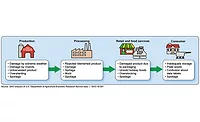Food Waste
Curbing food waste in industrial food production
Examining waste in packaging and production can offer solutions to decreasing overall waste in the plant

As World Food Day has just recently passed, we consider the issues of food waste and look at areas where waste can be decreased.
According to Vytenis Andriukaitis, European Commissioner for Health and Food Safety, in a world where more than 800 million people go hungry, it is unacceptable that in Europe, 88 million tonnes of food are wasted every year. This amounts to 143 billion euros per year. In the US, the picture isn’t any prettier. According to The Guardian, Americans waste 150,000 tons of food each day, equal to a pound per person.
Food waste happens at home, the grocery store, the plant where inefficiencies produce scrap, the farm—and anywhere else along the supply chain. Not only does food waste not feed the hungry people in the world, it creates issues for the environment as well—at landfills it sits creating methane gas as it rots. Keep in mind that this wasted food also used plenty of water and pesticides in its production.
Charlie Ahern, general manager at food packaging supplier Advanta, explains how manufacturers can boost profits in today’s competitive food and beverage industry.
Less waste, more profit: Boosting profits in food manufacturing
One of the most well-known methods of boosting profits in manufacturing is to reduce waste, and a common way to eliminate unnecessary waste is to adopt lean manufacturing methodology. New technologies, such as advanced supervisory control and data acquisition (SCADA) systems, are enabling better monitoring and management of common wastages on the factory floor, particularly unnecessary and excess machine motion and non-required waiting time during production.
However, due to the perishable nature of many ingredients in food and beverage manufacturing, some of the priciest wastages are related to overproduction, unnecessary inventory and product defects. Unfortunately, these wastages are often unavoidable, even with advanced technology to monitor production. That said, there are ways to reduce waste from other resources in food manufacturing, including lessening the waste related to food packaging.
We’ve all heard about the problem of excessive packaging on food products—and plastics tends to be the prime culprit. According to the Environmental Protection Agency (EPA), over three quarters of plastic material generated in the United States is currently sent to landfill. The finger is often pointed to consumers, urging them to follow recycling recommendations. However, there are steps that food manufacturers can take to alleviate this problem—and boost their profits in the process.
By shifting to a more recyclable material for packaging, like aluminum, manufacturers can take advantage of reimbursement schemes to exchange their unused packaging materials for cash. Because aluminum can be melted and reformed repeatedly, some food packaging suppliers can offer financial reimbursement for excess foil packaging supplies. This means that any aluminum that is not used by the manufacturer, can be resold back to the supplier, where recycling will be arranged. Good for the environment, and good for profit.
Invest in lifespan
Purchasing ingredients and supplies in bulk has long been considered a viable method of saving money for large manufacturers. However, not all manufacturers have the inventory space required to store these excess materials—and it’s certainly not ideal for manufacturers that rely on perishable products and raw materials. As an alternative, investments should be made to prolong the lifespan of products produced on site.
New packaging methods, such as modified atmosphere packaging (MAP), are enabling this. MAP describes the modification of the air inside packaging. By displacing regular air for low oxygen gases, the potential microbial growth is minimized, therefore prolonging the shelf life of the product. This is particularly advantageous for meat and poultry. Chicken products, as an example, can expand its lifespan by three times by using this method.
Skin pack, another method of extending the shelf life of poultry, uses vacuum packing to seal the meat to an aluminum or plastic tray, which is then sealed with plastic wrapping. This method, which was made aluminum-compatible by Advanta earlier this year, eliminates oxygen from the product. As a result, it can increase the shelf life of poultry by similar levels as MAP.
Controlled atmosphere packaging (CAP) can also be used to prolong the storing time of products at a manufacturing facility. This method requires the addition of oxygen absorbers to food packaging, to regulate the temperature and humidity of a product. This can be hugely beneficial for manufacturers that need to store food products for longer than initially expected.
Investing in these packaging methods can reduce the likelihood of spoiled inventory, particularly if a product line is not selling as well as expected, or if the product was overproduced. This can also reduce the impact of fines and reject orders from retailers if a particular batch of products is delivered with a shorter use-by date than agreed.
Food and drink production are the unsung heroes of the United States’ manufacturing economy. Bringing a colossal $126 billion to the economy each year, it is no surprise that the sector is becoming more saturated and competitive than ever before.
Every manufacturer is fighting to grab a slice of the industry’s lucrative profits, however increasing costs should not be the first option for manufacturers in this sector. Instead, the industry should assess opportunities to reduce its waste, both for packaging and spoiled products, in order to reclaim potential profits.
Charlie Ahern, general manager at Advanta, can be reached at 706-756-2335 or at charlie.ahern@advantapack.com.
Looking for a reprint of this article?
From high-res PDFs to custom plaques, order your copy today!









